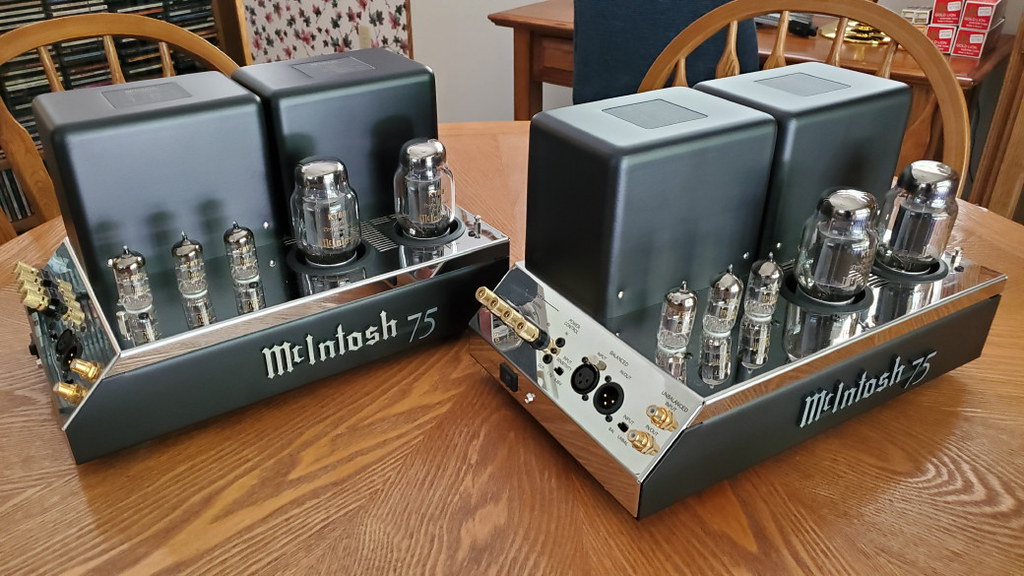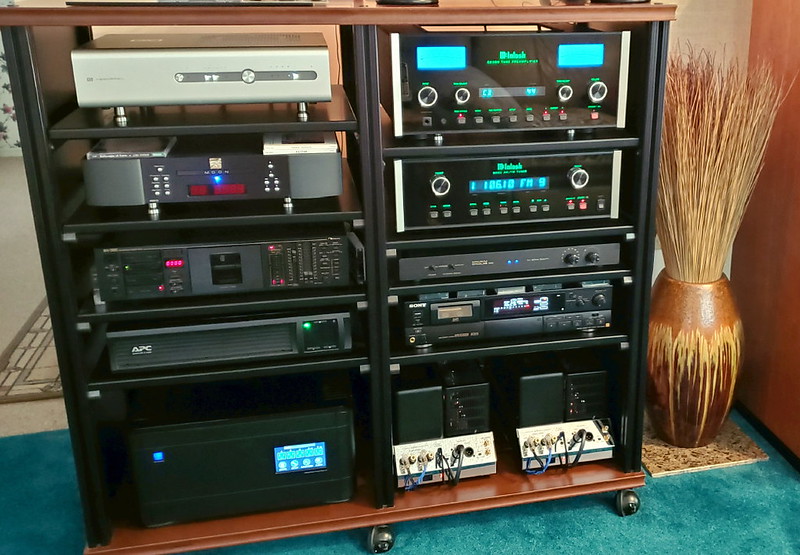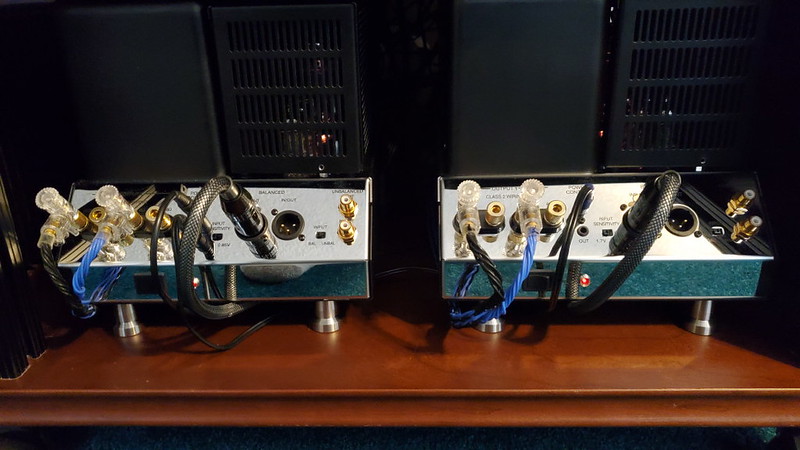
 |
|
|||||||
| McIntosh Audio A Tradition of Excellence |
|
|
Thread Tools | Display Modes |
|
#1
|
||||
|
||||
|
by J. Dan Daniell
 Ah, yes, the happiness that comes from enjoying my new MC75 MkIII mono tube power amplifiers. They are true beauties, endowed with a special charisma that instantly endears them to me. The latest iteration of these beloved mono tube amps, originally introduced in 1961, improves on every design aspect of the original and adds some additional features that offer modern advantages that deliver safety and convenience. The MC75 MkIII is the third version of this amplifier, the original, the 60th Anniversary Edition with the gold chassis packaged with the reissued 60th Anniversary C22 preamplifier in limited numbers, and the follow up version MC75 with the stainless steel chassis, hence the MkIII designation. The production of the latest MC75 amplifier ended in 2017, so locating a pair to purchase was challenging since most owners of these amazing tube amps aren’t parting with them. I can’t blame them. I have been asked a number of times what makes me consider the McIntosh MC75 MkIII mono tube amplifier a better choice than the MC275 MkV or MkVI stereo tube amplifiers. That is a good question and one that deserves to be discussed. Please consider that you are reading a subjective analysis, my personal opinion, which may or may not parallel anyone else’s experience, so kindly accept that as my disclaimer. Having owned and enjoyed three McIntosh MC275 MkV amplifiers used in two separate sound systems, I have intimate experience with these fine audio components. I have used the MC275’s in stereo operation and in paralleled mono operation, thus I can speak to both experiences with some authority. In stereo mode the MC275 is in its prime. The overall clarity and dynamic range is excellent with one caveat. That exception is the amplifier’s inability to remain in full control of deep bass under certain conditions. By that I mean the MC275 can occasionally have difficulty maintaining extended weight and control of low frequency dynamics and sustain without seeming somewhat soft and slow. This is not always evident but it is apparent from time to time with certain content. In parallel mono operation, which doubles the amplifiers output from 75 watts per channel in stereo to 150 watts mono, one would expect this bass issue to disappear, and for the most part is does, but at the expense of a slight loss in overall clarity across the entire frequency spectrum. It is my belief the MC275 sounds best in stereo mode. One of the first things I noticed with the MC75 amplifiers is a more controlled, dynamic, and powerful deep bass. My MC275 amplifiers, even when run in parallel mono mode did not have the same solidity, rapid attack, nearly infinite sustain, and rapid control of bass notes, particularly ultra-deep electronic synthesized bass. The MC75's considerably larger power supply for the single mono configuration delivers more sustained current to reproduce the lowest octaves than a MC275 is able to equal with its shared power supply. I am not saying the MC275's do a poor job reproducing the lowest octaves, but the bass was not always as well defined and energetic as the MC75s can reproduce effortlessly. Another impressive aspect with the MC75's performance is its silence. The faintest of sounds appear clearly out of absolute silence. The same is true for diminishing sounds such as piano notes that are held until decayed to full silence. The clarity of sustained sounds, even at their weakest points before silence takes over, is impressive. The MC75 soundstage is wide, deep, and sharply focused with complete separation of left and right channels typical for mono amplifier applications. Added to this, the more powerful and independent power supplies for each amplifier do not require sharing the weight of independent dynamic demands in each channel. Consequently a bass drum strike in the left channel not mixed at all into the right channel remains fully fleshed out and dynamic with absolutely no bleed over to the right channel. The individual strength of independent power supplies reaps huge benefits in helping develop an accurately defined soundstage and maintaining full range dynamics in each channel. Then there is the jaw dropping fluidity and textural richness of the midrange. Human voices are fully depicted in such a manner to have the identical timbre, character, and believable dimension as though voices were real, not reproduce. The tone, the breath, the vibrato, are all developed in such a three dimensional way it practically suspends reality, leaving me with the impression of human physical presence in the room rather than merely speakers and equipment.  The MC75 amplifiers are installed in my living room sound system nestled in the bottom right side on a two section Salamander Synergy rack. The sides of the rack are closed with panel inserts so the shelf cavity requires fans in order to pull enough air through the opening to keep the amplifiers at a comfortable and safe operating temperature. I have had fans installed in the shelf cavity for several years. Originally I installed the amplifiers without the tube cages but quickly discovered the radiant heat of the two KT88 tubes caused the left channel amp to heat the adjacent right channel amp’s transformer, and the right channel’s KT88 tubes were heating the wood side panel of the Salamander rack even with the fans in operation. Reinstalling the tube cages solved this issue. The cages actually act as heatsinks, absorbing the tube’s radiant heat and dispersing it throughout the entire cage, thus reducing the hot spots directly beside the KT88 tubes. Now the tube cages are warm to the touch but not hot. The transformer adjacent to the left channel KT88 tubes runs much cooler and the wood panel insert on the Salamander rack's right side is now only warm to the touch, not hot as before. Under my present installation circumstances the tube cages must remain installed. I am good with that. The MC75’s look great either way. So, how do the MC75 amplifiers sound? Here’s a clue. Does being glued to the sweet spot on my living room couch for four to six hours a day offer any insight? I had one day where I listened to the MC75’s for nine hours straight and still didn’t want to turn them off. These amplifiers are psychoactive. I mean they sound so good they are trance inducing, able to erase all thoughts beyond the music. They remind me very much of my MC2301’s in the studio system. Their sound signature is woven from the same silky material. It manages to wind these intricate threads through your consciousness unhindered by distractions. The sound embraces you like a lover. I have listened to countless recordings since installing the MC75’s in the living room system. Not surprising is how smoothly the McIntosh C2300 preamplifier integrates itself into the overall performance. Sources have been the Aurender N100H music server, the Simaudio Moon 260D transport, and the Schiit Audio Yggdrasil Analog 2 DAC. I have also spun some vinyl to my complete satisfaction. This is a sound system I could live with for eternity. Playing Norah Jones - Come Away with Me, “Cold Cold Heart” found me thoroughly engrossed. The acoustic bass was faultless with emphasis on the warm wood vibrations of the instrument’s body and the sumptuous tones of the plucked strings, but my jaw dropped when Norah’s voice appeared. The texture, realism, and genuine human characteristic of her voice was so distinct, so three dimensional I nearly fainted. Well, I didn’t faint but you get the idea. I was floored. I played this song twice just to be certain I hadn’t imagined the precision of the MC75’s performance. Inserting the CD from Fiona Joy, Signature – Synchronicity into the Simaudio Moon 260D transport I played the lead song “Ceremony”. This is a wonderful recording that features piano with instrumental accompaniment and vocals. The piano was reproduced with dynamic realism and air that was spellbinding. The bass was so solid and deep it left me with the impression I was listening to the MC2301 amplifiers, or perhaps the MC452 amplifier that previously graced this sound system. The impact, strength, and depth were startling. Background vocal harmonies floated through the space between instruments without clouding or crowding. Moving to the self-titled CD of Liz Longley I played “Skin & Bones”. The opening drum solo, joined with bass, then acoustic guitar was impressive. The drum strikes and the sound of the drum skins vibrating easily demonstrated the MC75’s ability to deliver continuous dynamics without losing control. The robust dynamic range was further emphasized when the bass appeared under the drums followed by the remarkably clear acoustic guitar on top. Liz Longley’s voice reminds me to some extent of Katie Malua with a bit more grit. Her voice was locked perfectly in the center of the soundstage. The entire performance was captivating. Switching from vocals to a jazz arrangement I played Brad Mehldau Trio - Anything Goes, “Dreamsville”. Brad’s piano is mixed across both channels, while the acoustic double bass is centered, and the drums are mixed left and right. The brushes on the drum skins and cymbals are held to the back of the mix to some degree and so is the acoustic bass, yet the MC75 had no problem revealing the subtle ring and decay of the cymbals as they were lightly tap with the brush. The sliding sound of brushes on tightly tune drum skins was also fully captured. The piano was mixed in a forward manner that displayed it as the primary instrument in the tune. The sound of the piano notes and chords was crystal clear, never smeared into the bass or drums. The MC75 displayed its jazz chops admirable. In the week that has followed since the MC75’s took their rightful place in the living room sound system I have played the amps almost continuously. I am approaching 75 hours on the new Gold Lion KT88 power tubes I installed in place of the McIntosh factory branded JJ Tubes. I estimate I have played over 100 recordings across all genres. I have discovered the MC75 amplifiers are extremely revealing, quite on the level of the MC2301’s. They do not sugarcoat a recording. When it’s good the performance is mesmerizing to the fullest extent. When a recording is low quality, and I have a few that’s for sure, the MC75’s shine a spotlight on all the imperfections. There’s no glossing over a poor recording. That’s exactly what I desire, an amplifier that tells the truth. That is what the MC75’s are giving me.  Speaking earlier of safety and convenience, two features have been included on the MC75 MkIII that elevates its value to an owner in a positive way. One is the inclusion of the McIntosh Sentry Monitor circuit. It continuously monitors the amplifier’s operational status without being in the audio circuit paths. If a short circuit happens or a power tube failure occurs the amplifier immediately shuts off and begins flashing the red LED at the center front side of the amplifier. Clear the short at the terminals, or replace the failed power tube, and you are back in business without damage to other internal parts. No trip to the service tech required. That is a blessing for tube amplifier owners. The second feature added to the MC75 that has long been desired is the inclusion of Power Control. This allows the amplifiers to be connected to a McIntosh preamplifier’s Power Control output so that the amplifiers can be energized from the preamp or the remote control without being required to manually turn each amp on or off at its rocker switch. The Power Control feature on the MC75 amplifiers is a welcomed user convenience that is long overdue on other McIntosh tube amps. Press one button and the entire system turns on as it should. I have tube rolled the MC75’s right out of the factory cartons. The factory branded JJ Tubes were replaced with Gold Lion KT88’s, Siemens ECC801S/12AT7 tubes, and Gold Lion ECC83/12AX7 tubes. In addition, the amplifiers factory power cords have been replaced by Wireworld Silver Electra’s with a Furutech Flux 50 in-line filter plugged into the power jacks of each amplifier. Both amplifiers are fed from a dedicated 20 amp circuit that is terminated to a PS Audio Soloist Supreme SE receptacle at the wall outlet. Yesterday I swapped the Siemens ECC801S/12AT7 tubes for Siemens E81CC/12AT7 triple mica tubes. They are the premium version of Siemens 12AT7 tubes. I immediately noticed a slight improvement in the space between instruments, more air if you will, and a tiny bit more definition to the upper midrange. These tubes already had 115 hours on them so there was no issue with additional break-in required. Today the MC75’s have been playing since 9:30 AM and sounding completely immersive. Since installing these wonderful tube power amplifiers in my living room rack I added Stillpoints Ultra Mini isolation footers under both amps. Once again I am thoroughly impressed with the sonic improvements. The living room sound system already has Stillpoints Ultra Mini's under the McIntosh C2300 preamplifier, the Aurender N100H music server, the Schiit Audio Yggdrasil Analog 2 DAC, and the Simaudio Moon 260D transport. It was a natural progression to add the Ultra Mini's under the McIntosh MC75's. What amazes me is how an already premium sounding system at a performance level that is extremely high can be further enhanced by continuing to place Stillpoints under more components. The Ultra Mini's supporting the pair of MC75's have elevated performance. Immediately noticeable is a greater sense of space between all instruments and voices. Soundstage focus has grown more pinpoint accurate, sustained notes seem to linger forever, dynamic attacks have become more immediate and detailed, and the earthy timbre of instruments and voices seem more intimately interconnected than before. The living room sound system has never sounded more grandeur than it does now.  So that’s it, my take on the MC75 MkIII mono tube power amplifiers. Some individuals have suggested I would miss the MC452 that the MC75's replaced. I can lay that notion to rest. The MC452 is a fabulous solid state power amplifier with gorgeous power meters and burly handles. It is impressive, but I do not miss it for a second with the MC75’s filling the shoes. There is a special organic essence present in the performance of the MC75 tube amps that is seemingly absent in solid state amplifiers. To those who counselled me against trading my MC452 for the MC75’s, sorry guys, you were wrong. No regrets fellows, I am ecstatic that I was able to find this pair of MC75’s to call my own.
__________________
Dan  STUDIO - McIntosh C1000C/P, MC2301 (2), MR88, Aurender N10, Esoteric K-01X, Shunyata Sigma spdif digital cable, Sonos Connect, PurePower 2000, Stillpoints, Furutech Flux 50, Michell Gyro SE, Michell HR Power Supply, SME 309, Ortofon Cadenza Black, Wireworld, Sonus faber Amati Anniversario LIVING ROOM - McIntosh C2300, MC75 (2), MR85, Magnum Dynalab 205, Simaudio MOON Neo 260D-T, Schiit Audio Yggdrasil, Aurender N100H, Shunyata Sigma USB cable, Micro Seiki DD40, Ortofon Cadenza Blue, Nakamichi BX-300, Sony 60ES DAT, PS Audio P10, Furutech Flux 50, Sonos Connect, Stillpoints, Wireworld, Kimber, PMC EB1i, JL Audio f113 VINTAGE - McIntosh MA230, Tandberg 3011A tuner, Olive 04HD, Sony DTC-59ES DAT, McIntosh 4300V, JBL 4312A Last edited by jdandy; 10-04-2019 at 10:36 AM. |
|
|
| Audio Aficionado Sponsors | |